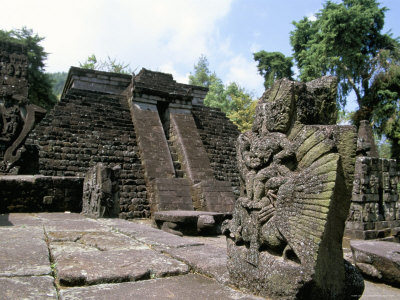 |
| Sukuh Temple |
 |
| relief of sukuh temple |
 |
| relief of sukuh temple |
The structure of the temple
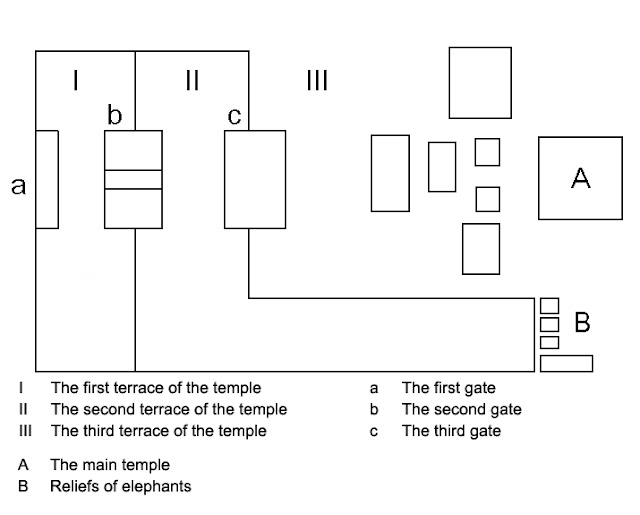 |
| Sukuh temple plan. |
Sukuh the temple gives the impression of a striking simplicity to the visitors. The impression gained from this temple is quite different from those obtained from the major temples in Central Java, the other is the Borobudur and Prambanan Temple. Even the shape of the temple Sukuh tend to be similar to the Maya in Mexico's cultural heritage or cultural heritage of the Incas in Peru. This structure will also remind visitors of the forms of pyramid in Egypt. Below will be discussed further on this form.
 |
| sukuh tmple and pyramid aztec |
The visitors who enter the main door and enter the biggest gate will see the typical architectural form that is not arranged perpendicular but somewhat oblique, trapezoidal in shape with a roof on it.
The stones in this temple is slightly reddish in color, because the stones used is the type of andesite.
The first terrace of the temple
 |
| sukuh temple |
The main gate of the temple Sukuh.
On the first terrace there is a main gate. At this gate there is a Sangkala in the Java language, which reads abara wong blind arches. This means that in the Indonesian language is the "Gate of the giants prey on humans". These words have meaning 9, 5, 3, and 1. If you get behind the Saka year 1359 or in 1437 AD.
The second terrace of the temple
The gate on the second terrace is damaged. On the right and left arch is usually a statue or Dwarapala doorman, was found also, but in a state of disrepair and is no longer amorphous. The gate is not on the porch roof and was not found many statues. But at this gate there is a candrasangkala also in the Java language, which reads wiku anahut elephant's tail. This means that in the Indonesian language is the "elephant tail biting priest". These words have meaning 8, 7, 3, and 1. If you get behind the Saka year 1378 or 1456 years BC. So if the number is correct, then there is a difference of nearly twenty years with the first gate on the porch!
The third terrace of the temple
On the third terrace there is a large courtyard with the main temple and some relief on the left and the statues on the right. If the visitors want to visit this holy temple, the rock staircase is relatively higher than the previous stone staircase to go. In addition too narrow aisle. It is said that architecture is deliberately made so. For the main temple is similar to the shape of the vagina, according to some experts, is designed to test the virginity of the girls. According to the story, if a girl is a virgin climb, so will her hymen tear and bleed. But if he was not a virgin anymore, then when the stepping stones of these steps, the fabric will tear and wear off.
Just above the main temple in the middle there is a square that looked like a place to put offerings. Here there are traces of incense, incense and incense is burned, so it looks one often used for worship.
Then on the left side of the main temple there is a series of reliefs that are the main mythology Sukuh and has been identified as a relief Sudamala Song of the story. The order of relief is as follows.
Relief first.
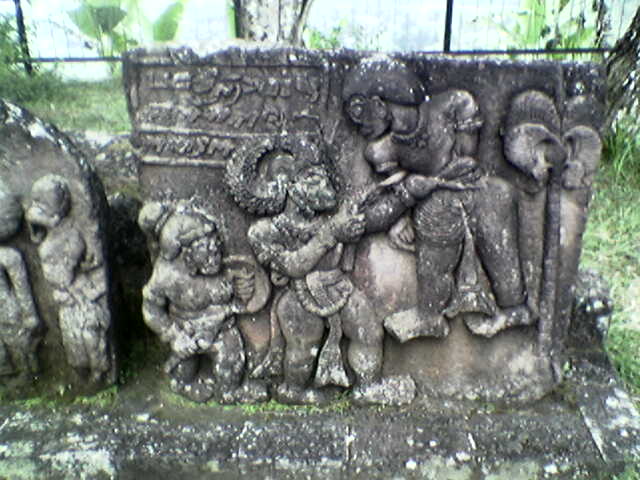 |
| relief of sukuh temple |
Depicted on the left side of the Sahadeva or Sahadeva, Nakula and twin brother is the youngest of the five Pandavas. Both are sons of King Pandu Madrim, his second wife. Madrim died while Nakula and Sahadeva were little and they are cared for by Dewi Kunti, wife of Pandu major. Kunti then nurture them along with three sons of Pandu: Yudhishthira, Bhima and Arjuna. This relief depicts a squatting Sadewa and followed by a clown-servant or attendant. Faced with a heroine Sadewa terlihatlah the Goddess Durga is also accompanied by a clown-servants.
Relief second.
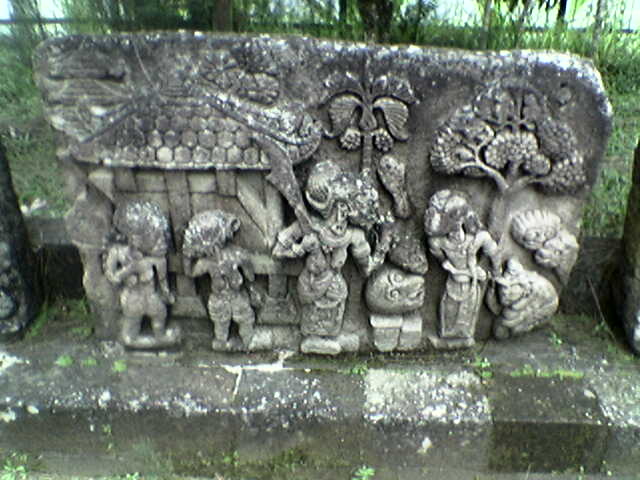 |
| relief of sukuh temple |
On this second relief image carved Goddess Durga which has turned into a raksasi (giantess) who faced terrible. Two giant horrible and Kalañjaya Kalantaka Batari accompany Durga was furious and threatened to kill Sadewa. Kalantaka and Kalañjaya is an incarnation of goddess condemned for not respecting God and should be born as an ugly giant. Sadewa tied to a tree and threatened with death by the sword for refusing to release Durga. Behind it, among others, there is Semar. Visible form of ghosts that hover above the trees and the right side there are two small owls. This seems awful painting is a painting in the woods Setra Gandamayu (Gandamayit) where the disposal of the gods who were expelled from heaven because of a violation.
The third relief.
 |
| relief of sukuh temple |
In this section we described how Sahadeva with punakawannya, Semar dealing with the blind hermit named Tambrapetra and her daughter at the hermitage Prangalas Padapa Ni. Sadewa will cure him of his blindness.
Relief fourth.
 |
| relief of sukuh temple |
The scene in a beautiful park where the Sadewa was chatting with her daughter Tambrapetra and Ni Padapa and a clown-servants in the monastery Prangalas. Tambrapetra thank you and give his daughter to Sadewa to marry.
Relief fifth
| relief of sukuh temple |
This painting is a scene of a power struggle between Bhima and the two giants Kalantaka and Kalañjaya. Bima with extraordinary powers are being raised both these giants to be killed with nail pañcanakanya.
 |
| The statues of Garuda |
 |
| Inscription in sukuh temple |
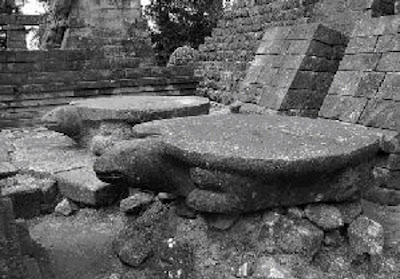 |
| statues of a turtle in sukuh temple |
See the story of the Sea Finding Amrita Screenings
Several other buildings and statues
In addition to the main temple and the statues of turtles, eagle and reliefs, was found also some animal-shaped sculptures wild boar (wild boar) and saddled elephant. In the ancient times of knights and nobility berwahana elephant.
 |
| relief of sukuh temple |
Then there were the Horseshoe berelief building with two human figures in it, and right next to think that face each other. Some argue that these reliefs symbolizing the womb of a woman and left of the figure represents the evil and the right figure represents virtue. However this is not so clear.
 |
| relief of sukuh temple |
Then there is a small building in front of the main temple called the temple pewara. In the center, the building is perforated and there is a small statue without a head. This sculpture by some of the reasons often given are sacred offerings.




{ 0 comments... Views All / Send Comment! }
Post a Comment
What your impression??